According to the American Optometric Association (AOA), 25 percent of all children, or 1 in 4 students, have a vision problem significant enough to impact their learning.
Suppression of an eye is when the brain ignores the visual signals provided by one eye. Essentially, suppression is a method of compensating or adapting for a specific vision condition, like amblyopia (lazy eye) or strabismus (cross eyed). With normal vision, the eyes are aligned and have an equally clear image.
Suppression is a visual deficit that is associated with other strabismic and non-strabismic anomalies. Successful and long- lasting treatment of suppression is dependent upon the effectiveness of the treatment of the associated visual conditions.
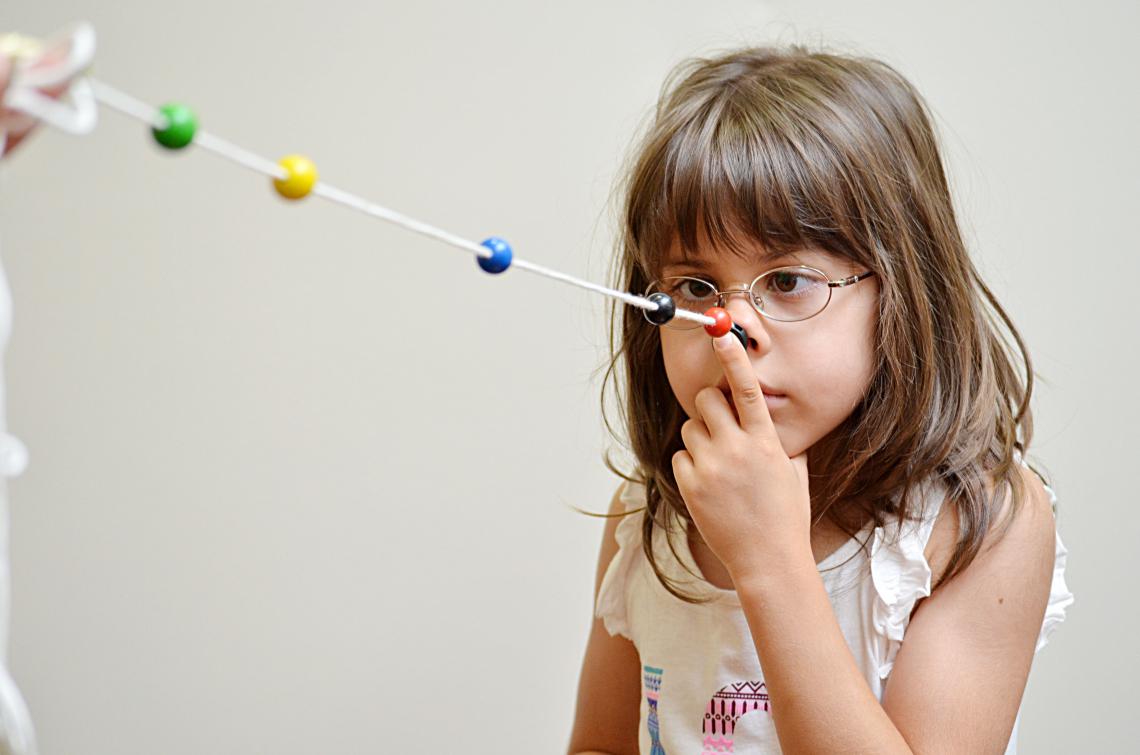
A child may pass a visual acuity eye exam and still have an undetected vision problem— mainly because 20/20 eyesight does not indicate “perfect” functioning of the visual skills. In other words, visual problems do not only stem from blurry vision, but can be caused by reduced visual skills as well.
Vision problems do not go away on their own and will persist into adulthood if not treated. In many cases, adults are not even aware that their difficulties are caused by a vision problem— leading to years of avoidance of difficult activities.
Therefore, it is essential to obtain an accurate diagnosis of a vision problem, and appropriate treatment as early as possible.

Vision problems can impact:
- Reading
- Spelling
- Handwriting
- Reading comprehension
- Homework completion
- Classroom performance
- Concentration and attention
- Visual arts
Depiction of predictions for refoveating Müller's stimulus with eyes moving independently or eyes following Hering's law of equal innervation.
Any condition that hampers vision or the processing of vision may result in problems learning. Vision disorders may interfere with reading and learning. The eye is literally an extension of the brain. It is estimated that over 60% of the brain has some duties associated with vision input.
- Suppression is the act of one of the eye’s shutting down visual input being sent to the brain. This can happen intermittently or be constant. Suppression could also be isolated to one eye or alternate between both. Usually this happens when binocular vision cannot be achieved so in order to compensate an eye would suppress the visual information.
- Suppression may also occur when there is a difference in refractive error in each eye. This condition is called anisometropia. Deprivation of visual stimulus caused by a congenital cataract may also cause suppression.
- Suppression of an eye is a subconscious adaptation by a person's brain to eliminate the symptoms of disorders of binocular vision such as strabismus, convergence insufficiency and aniseikonia. The brain can eliminate double vision by ignoring all or part of the image of one of the eyes. The area of a person's visual field that is suppressed is called the suppression scotoma (with a scotoma meaning, more generally, an area of partial alteration in the visual field). Suppression can lead to amblyopia.
- Suppression essentially refers to the brain ignoring the visual signal provided by one eye. Let's start with a normal pair of eyes. When the eyes are aligned and pointing towards the same object in space and have an equally clear image, the brain uses small cues to determine the depth, size, shape, etc. of the object and combines the images of each eye together to see.
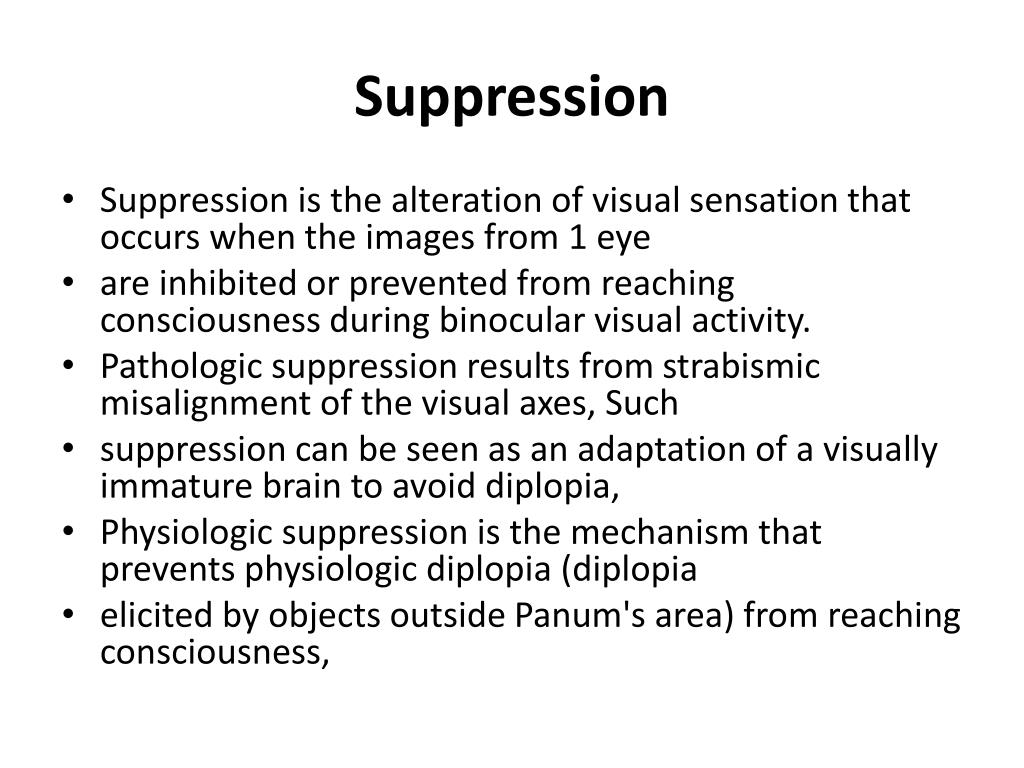
If one eye has a very blurry image (amblyopia, specifically refractive amblyopia due to an unequal glasses prescription) the brain struggles to combine the images of each eye together into a single image. To compensate, the brain suppresses or ignores visual input from the blurry eye. This same concept occurs if one eye is turned (strabismus or squint). In this example, the brain sees multiple images, which would be confusing. Again, the brain suppresses (ignores) visual input from the deviating eye and utilizes input from the fixating eye.
At its core, suppression is the visual system's method of compensating or adapting for a defect. To avoid the confusion of a blurry image superimposed on a clear image, or seeing two of one image in space, the brain simply ignores the abnormal image. Suppression is rather easily "learned" by the brain at an early age when the visual system has a higher degree of neuroplasticity. In contrast, a patient that suddenly acquires a strabismus or squint later in life may have trouble suppressing and constantly see double.
For amblyopic patients, a critical issue stems from long-term suppression. Suppression can be difficult to "unlearn". One of the key components of visual rehabilitation for patients that have amblyopia or strabismus is to teach the brain to use both eyes together. Tests of suppression check for the presence of suppression and, in some cases, quantify the amount of suppression the visual system is experiencing.
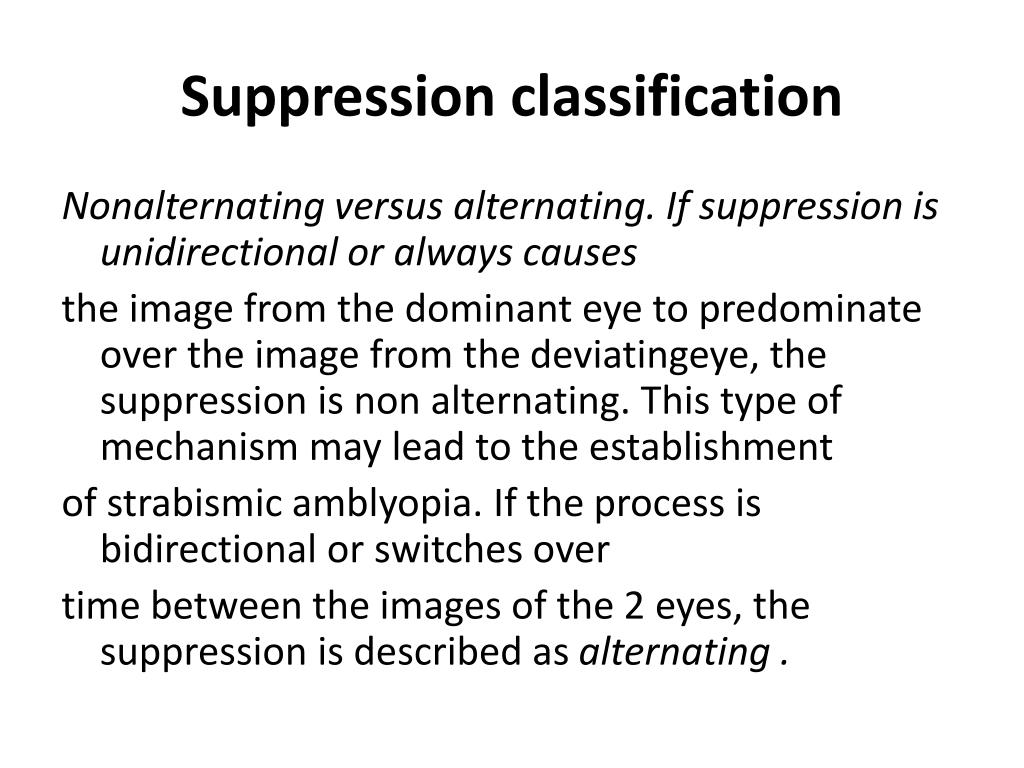
suppression amblyopia -- medical-dictionary.thefreedictionary.com eResearch by Navid Ajamin -- summer 2013
suppression of the central vision in one eye when the images from the two eyes are so different that they cannot be fused into one.
This may be due to:
- faulty image formation (sensory amblyopia);
- a large difference in refraction between the two eyes (anisometropic amblyopia);
- the two eyes, pointing in different directions (strabismic amblyopia).
Most suppression amblyopia can be reversed if appropriately treated before age 6 years.
a partial loss of vision, usually in one eye, caused by cortical suppression of central vision to prevent diplopia. It occurs commonly in strabismus in the eye that deviates and does not fixate. Early recognition of strabismus and amblyopia is essential because occlusive therapy that forces use of the bad eye may dramatically improve the child's vision if begun early. It becomes progressively less effective with increasing age but may improve vision even up to 9 years of age. Without therapy, near-blindness in the affected eye may result, but common acuity loss is 20/40 to 20/400.

Binocular interaction
Apart from binocular summation, the two eyes can influence each other in at least three ways.
Pupillary diameter. Light falling in one eye affects the diameter of the pupils in both eyes. One can easily see this by looking at a friend's eye while he or she closes the other: when the other eye is open, the pupil of the first eye is small; when the other eye is closed, the pupil of the first eye is large.
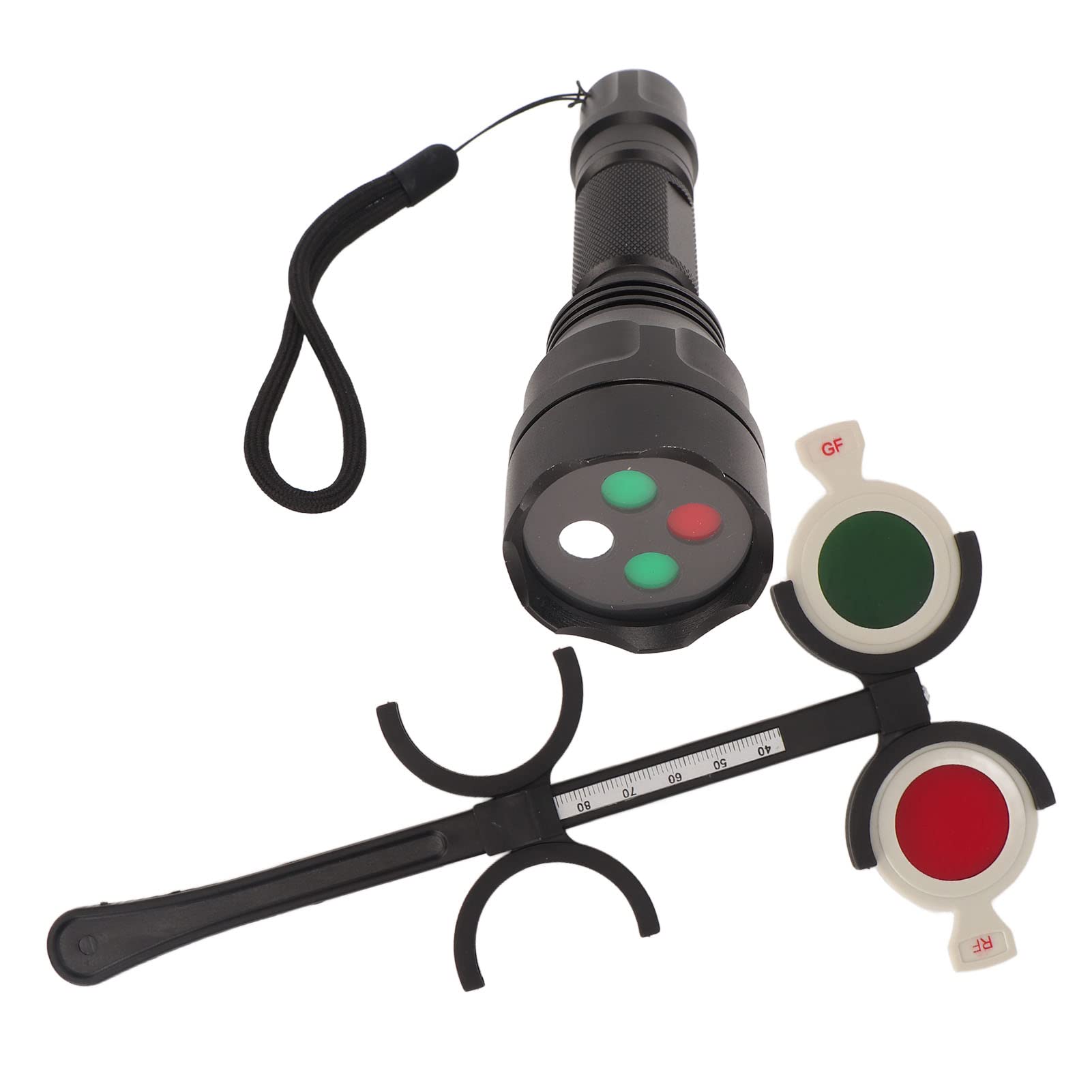
Accommodation and vergence. Accommodation is the state of focus of the eye. If one eye is open and the other closed, and one focuses on something close, the accommodation of the closed eye will become the same as that of the open eye. Moreover, the closed eye will tend to converge to point at the object. Accommodation and convergence are linked by a reflex, so that one evokes the other.
Interocular transfer. The state of adaptation of one eye can have a small effect on the state of light adaptation of the other. Aftereffects induced through one eye can be measured through the other.
Grating acuity, interocular suppression and binocular interaction were evaluated at different positions in the visual field of strabismic humans with alternating fixation. In all cases, the suppression of the deviated eye was most intense in a region corresponding to the fovea of the fixating eye, but reduced or absent in the periphery. In addition, suppression was found in part of the peripheral visual field of the fixating eye. For most subjects, the monocular properties of both eyes were normal. However, for one subject with a strong preference for one of the eyes, visual acuity and luminance detection were selectively impaired in the chronically suppressed regions of the non-preferred eye. Regardless of which eye was currently used for fixation, the visual information available to the subject came from both eyes. In parts of the visual field, the two eyes tended to replace each other. In the far periphery, and especially in the upper and lower hemifield, signals from the two eyes were often combined in a binocular perception of depth.
Related image Suppression may treated with vision therapy, though there is a wide range of opinions on long-term effectiveness between eye care professionals, with little scientific evidence of long-term improvement of suppression, if the underlying cause is not addressed (strabismus, amblyopia, etc.).
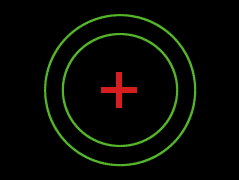
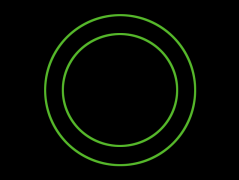
- Schober's test. If suppression of the amblyopic eye is weak, the cross may be seen "blinking".
- Schober's test often helps in the diagnostic assessment of children with anisometropic amblyopia.
- The test picture contains two green rings and a red cross. When viewed through red - green lenses a binocular person sees both the rings and the red cross.
Sometimes the child tells that (s)he sees the cross "blinking", i.e the cross appears for a short time and then disappears again for a short time. In such a case suppression is weak and can usually be broken in a short time. Since we usually do not have follow-up visits sooner than a month, it is not possible to know how soon the function became normal. If the child has intensively trained the amblyopic eye, visual acuity may become normal within a month. Training must be both fun and demanding; nowadays many children like to play different electronic games, the smaller, the better.
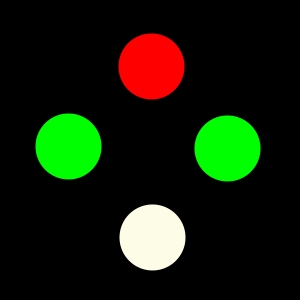
ANTI SUPRESSION
Patients with unstable visual systems often learn a neurological adaptation called suppression, in which their brains block the visual input coming in from one eye. People unconsciously learn to suppress at very young ages to keep from seeing double. Suppression is never normal and is always a sign of an unstable visual system.
Vision therapy trains the eyes to work together but to do so both eyes have to be “on.” Therapists work with patients using special red-green lenses and a target with red-green letters. One eye can only see the red letters, and the other the green. If the visual system shuts off an eye, the patient won’t be able to see all of the letters. Anti suppression activities such as these make the patient aware of when she is suppressing and allow her to gain control and learn to leave both eyes on simultaneously. This is especially important for patients with wandering eyes, crossed eyes, and lazy eyes.

Reference:
- strabismusworld.com
- en.wikipedia.org/wiki/Binocular_vision
- en.wikipedia.org/wiki/Suppression_(eye)
- medical-dictionary.thefreedictionary.com
- lea-test.fi/en/assessme/stpeter/index.html
- amplifyeye.care/article/what-is-suppression
- icarevision.com/eye-tests/are-you-using-both-eyes
- sciencedirect.com/science/article/pii/0042698982900256
- seevividly.com/info/Binocular_Vision/Vision_Tests/Suppression_Tests
- allagesvisioncare.com/vision-therapy-treatment-devices-and-methods
- aoa.org/healthy-eyes/eye-and-vision-conditions/vision-related-learning-problems
- focusvisiontherapycenter.com/vision-therapy-glossary-a-z/suppression-of-binocular-vision
- optometrists.org/vision-therapy/guide-vision-and-learning-difficulties/vision-and-learning-difficulties
See Also:
- The Measurement and Treatment of Suppression in Amblyopia -- ncbi.nlm.nih.gov
- Eye Exercise to Overcome Suppression and Muscle Imbalances, and Strengthen Fusion
- The Relationship Between Fusion, Suppression, and Diplopia in Normal and Amblyopic Vision
- Efficacy of anti-suppression therapy in improving binocular vision in children with small-angle Esotropia

 وبلاگ تخصصی عینک شامل مجموعه مطالب پزشکی است که اطلاعات مفیدی در رابطه با عینک , چشم، لنز، سلامتی چشم و راه های پیشگیری از بیماریهای چشمی، کنترل و درمان آن را در اختیار شما کاربر محترم می گزارد.
وبلاگ تخصصی عینک شامل مجموعه مطالب پزشکی است که اطلاعات مفیدی در رابطه با عینک , چشم، لنز، سلامتی چشم و راه های پیشگیری از بیماریهای چشمی، کنترل و درمان آن را در اختیار شما کاربر محترم می گزارد.